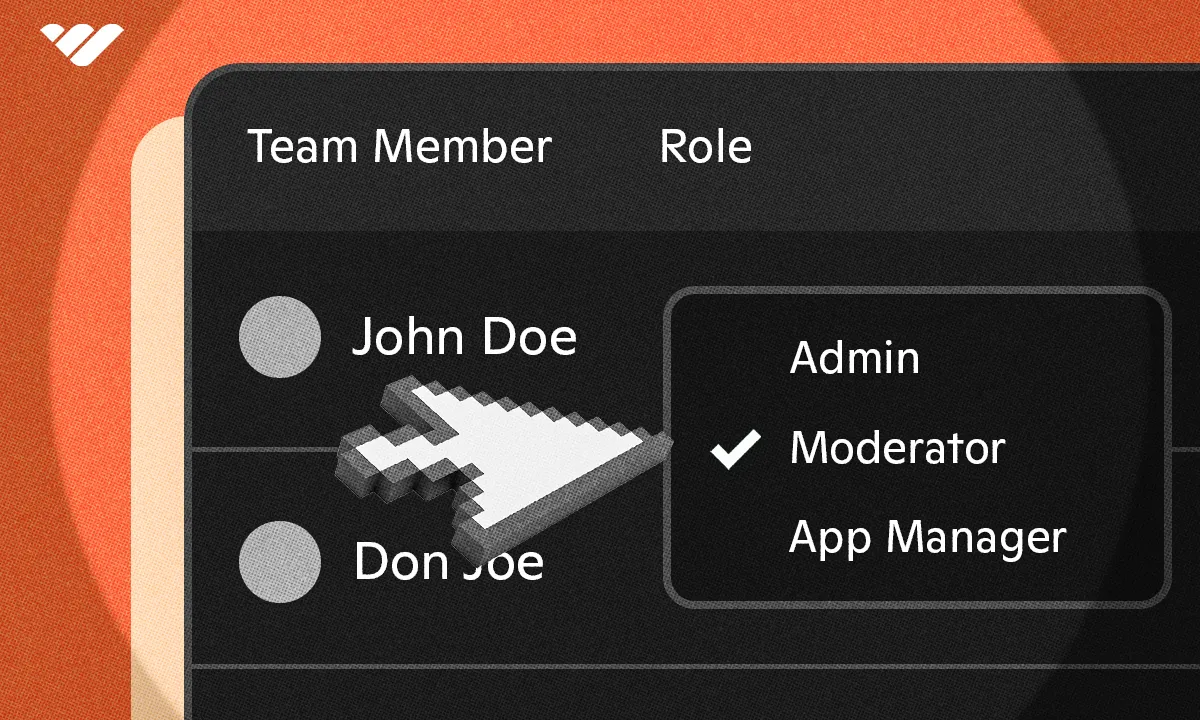Engagement is key to any successful online community. There are many ways to measure engagement, from new member numbers to UGC.
Key takeaways
- Track conversion rates, churn, and active member counts to understand if your community delivers real value.
- High engagement reduces moderation needs as satisfied members self-regulate and help newcomers.
- User-generated content from engaged members provides free marketing and drives organic community growth.
When running an online community, keeping it engaged is crucial. You can measure community engagement by tracking conversion rates, UGC, new subscriptions, and total active members.
You also have to ask yourself some important questions about your audience.
Do they like the content you post? Do they actively engage with each other? Are they offering feedback on how you can improve the community?
To find the answers, you need to review metrics, evaluate where your community is lacking, and gauge areas where you can improve overall.
We’ll go over some of the key community engagement metrics you’ll have to consider, the best tools to measure these, and check out why Whop has the best tools to help you evaluate your community engagement.
Why does community engagement matter?
"The people inside of the communities are the ones that are cheerleading for you the most.
They support you and therefore you need to make sure [...] that they're actually excited to go along this journey with you."
— Jasen Hunt, professional CAD instructor and online creator
Community engagement is your primary metric to understand if your community is happy with what you offer them. If members actively engage with your content, or if you have people returning to your community daily, they believe they’re getting their money’s worth.
Think of it this way. If you were active within a community, wouldn’t that mean you enjoy being part of it? And, if you like what the group offers, wouldn’t you happily pay the monthly fee to remain part of it?
In essence, active members are your moneymakers. And so, you must keep them engaged, keep them active and happy, to maintain high recurring revenue.
Now, we get back to the main question: how can you calculate how engaged your community is? Let’s find out.
How to evaluate community engagement in 8 different ways
Evaluating community engagement can be done in tons of different ways. Instead of going over the most minuscule of these, we’ll cover 8 of the main ones you’ll have to consider. These will be more than enough while not being too overwhelming on your side.
1. Find your conversion rate
Your conversion rate is one of the more general metrics that will help you gauge your community engagement. This can be interpreted in a couple of different ways.

The main conversion rate we suggest you take into account is trial conversions. If free trial users become paying members, they find enough value within the community to pay the fee.
Another conversion rate you can measure is your views compared to the number of site visits. If, for example, you have 1000 visits to your site per month, which leads to 20 new monthly memberships, that’s a 2% conversion rate. This means that users consider your community a good value for their money. Ideally, you should aim for a conversion of 2% or higher, with 4-5% being a pretty good rate.
2. Calculate how many new members join each month
Member growth is arguably the most important metric for community engagement. If your community stops growing, members won’t find enough value in what you offer.
Through most online community platforms, like Whop, you’ll be able to see your member growth over different periods. So, if you noticed a higher-than-average member growth during Q2 when you started posting different content or added an extra perk to your membership, users found enough value to convert to members.
The same is true vice versa. So, if you put an existing perk behind a higher paywall in March and noticed that your member growth decreased, you should probably reintroduce that perk to the regular membership.
3. Discover how much UGC is being produced
Now, let’s get into the community operations themselves.

One key thing to look out for is how much user-generated content (UGC) is being produced by already existing members. This can be social media or blog posts, forum discussions, and so on.
Think of it this way. If you’re truly engaged within a community, wouldn’t you be more than happy to share your experience with like-minded folks? From the group’s owner's perspective, this also means free publicity and, potentially, more member growth.
4. Total active members (daily, weekly, monthly)
Active users are engaged users, so having a higher total active member count is a way to measure your engagement. That said, the numbers might not tell the whole story, so we suggest you note their correlation.
For example, if your daily (DAUs), weekly (WAUs), and monthly (MAUs) users are the same, you can safely say that every member engages with your community at least once a day. At that point, you’ve reached optimal engagement.
A more realistic example is when, for every DAU, you have 5 WAUs and 20 MAUs. So, if you have a 1000-member community with all of them engaging at least once a month, you’ll have 50 daily active users and 250 weekly users. Your goal is to get these numbers as close to 1000 as possible, as that’d mean that all members engage with your content or each other weekly or even daily.
5. How much moderation is needed

One metric that you might not have considered is moderation. In general, the less moderation a community needs, the more engaged its members are. Let’s go over a few examples.
Let’s say that you have a community around fitness. Engaged members will have become experts, so they can spread factual information across the community chats, helping out new members and reducing the amount of moderation you’ll need to do.
Also, if your members are happy with what you’re offering, they won’t resort to bad-mouthing the community and leading new members to churn. In fact, when you inevitably have some trolls hop on to your chats, the engaged members will act as moderators themselves and prevent any unconstructive criticism from gaining traction or outright lead the trolls to get banned quickly.
6. How many users see your product
A more general metric that we already hinted at above is product views. Or how many users “know” that your community exists. This isn’t necessarily an engagement metric within the community but, rather, a way to measure your total reach.
Now, this is a way to see if your community engagement goes beyond the community itself. You can have specific tracking links to see what marketing methods are really working for your community. In turn, you’ll gauge what your potential members will be engaged by and, thus, be able to retain more of them.
For example, if you get a wider reach from sharing screenshots of your community actively chatting with each other, it’s safe to say that your potential members want to chat with like-minded folks more than anything else. Thus, you can refocus on optimizing that part of your community rather than creating more offerings.
7. How many users actively engage with your content
Knowing how many users are active in your community is great, but let’s take it a step further. Measuring the number of members who actively engage with your content will be a great way to see if your current content is actually of interest to your members.

If your active members only engage with each other, that’s obviously great. But, if they don’t really care about your other offerings, they’ll inevitably leave your community and, usually, create their own with members they’ve chatted with on yours.
"Inside your Whop, it's super important to keep the energy flowing. The easiest way to do this is by dropping a question or a quote at the beginning of each day.
Drop that in the chat, that's going to get members active and engaged."
- Lucas Duncan from Whop
If you see that many active members also engage with your content, you can double down on that part of your community. In turn, you’ll have plenty of members who will happily buy your next course, join your next webinar, etc.
8. How many users churn
The churn rate is one of the most important metrics for a community as a whole. When members leave your community, it always means that they either don’t find the value they used to or that the quality of the community has dropped.
And, in terms of engagement, it just means that they’re not engaged anymore. If you have a high churn rate, your group likely needs an overhaul. You might need to add more offerings, increase moderation, or even focus on a different topic.
All of these metrics are equally important to measuring community engagement. But how can you further evaluate these? What are the best tools to help you gauge these metrics?
The best tools for evaluating community engagement
There are countless different tools you can use to evaluate community engagement. But, we’ll focus on some of the primary ones that will help you measure the metrics we mentioned above.
Forums
Forums are an incredible way to see how members interact with your content, as well as how they engage with each other. Hosting a forum around your community will help you:

- Get some great UGC
- Measure how many active users you have
- See how many of these users engage with your content
If, for example, you start posting content on the forum, you can see how many impressions, likes, and replies they get, which are dead giveaways for engagement.
Feedback forms and surveys
An equally great tool is feedback forms and surveys. These are the most direct ways to get feedback from your members and are usually a great way to gauge your community’s engagement.
If you get a bunch of people on surveys and forms, it means that they’re actively trying to help you improve the community. Thus, they can help you see how many active and engaged members you have.
Paid active user statistics
There are tons of stats you can find around paid active users. After all, you want your community to be engaged so that you can make some money off it. Some of the stats you should look for are:
- The number of paid active users
- The amount of money active users spend
- Your churn rate
As we’ll see below, you can find all 3 statistics on your whop’s Dashboard.
Retention and conversion calculators
In a similar fashion to the stats above, retention and conversion calculators will give you a direct idea of how engaging your community is. Ideally, you’ll need a platform that handles the calculations and gives you the total number.
What about community management software?
Community management software (CMS) is great for tracking all the metrics and automating many of the calculations. However, there are tons of options out there, and many of them are, unfortunately, not the best.
But, if you want your community to be the best, you need all the data right in front of you without missing any features. That’s why we suggest you host your community through Whop, as you’ll be able to get all the data you need on your whop’s Dashboard. Now, what data are we talking about? Let’s find out.
Why Whop is the best Platform and tool for measuring community engagement
Whop is your best bet when it comes to measuring your community engagement. We won’t just boost our ego with this but simply give you the facts about why that’s the case.
All the data you need
The moment a user joins your whop, you’ll instantly get access to tens of different data points you’ll need for your community. We’ve already hinted at some of these above, but a brief list of the most important ones includes:
- Trial conversion rate
- Churn rate
- Page visits
- New users
- Paid active users
And many more. You’ll get access to how much each user has spent on your community, what other communities they’re part of, and so on. Plus, you can compare this data with previous periods to see how much your community has declined or grown since. All that is included when you create your whop, so you won’t need to pay anything extra.
Apps to keep your community engaged in one place

Realistically, having a community with just a chat isn’t going to bring in thousands of members. You need other ways to keep them engaged, like courses, webinars, posts, forums, etc. You can find all of these within your whop, all of which come with their own set of data.
For example, when you create a post on your forum, you’ll see how many impressions and likes it has. Or, if you have a course, you can see how many members have completed it, who the best students are, etc.
All of that comes in one place: your whop. So you won’t need to integrate with different platforms.
Tracking links to measure marketing reach

Another great tool you’ll find on your whop is tracking links. You can create unique links to see which ones are bringing in the most reach, which ones are converting more, and which ones are bringing in the most revenue.
That way, you can see what really catches the attention of your potential members and double down on it to keep your community’s growth high.
Reviews and questions

We know that feedback is king in any community. That’s why you’ll be able to get reviews and questions from your members directly on your whop’s page.
Besides being a potential way to get some UGC, it’s also a great way to engage with current and potential members. If they have a question, that can pop that into your page, and you can answer it directly, making it more likely for them to become part of your community.
Quick actions from your Dashboard

This is obviously a lot to take in at once. All the stats, all the metrics, it’ll get overwhelming. That’s why quick actions are the first things you’ll see on your Dashboard.
These can be anything from handling disputes, greeting new users, reaching out to churned users, etc. This way, anything that requires your immediate attention will be right there, in one place.
Create an engaged, thriving community with Whop
You’ve got your community ready, you know how to measure its engagement. So, what’s next?
Well, if you want all the metrics and data done for you, a suite of apps to get engagement even higher, all at just a 2.7% + $0.30 fee per transaction, you have to create your whop.
Even if you have a Discord server or Telegram channel, we’ll help you migrate that straight onto your whop without disrupting your community and, most importantly, lowering engagement.
If you’re ready to create an engaged community with Whop, sign up today. Create your whop or migrate your existing community to the platform within minutes.

